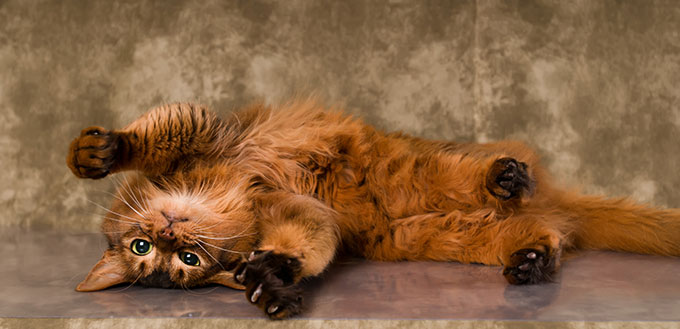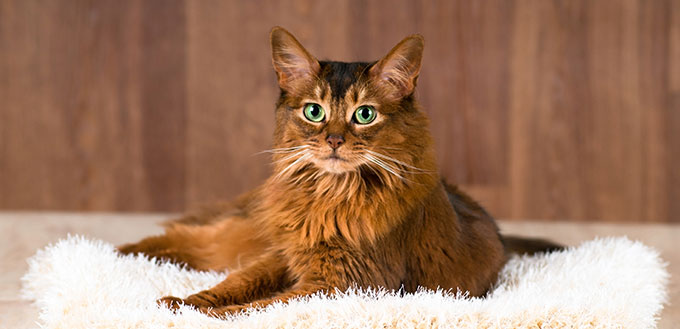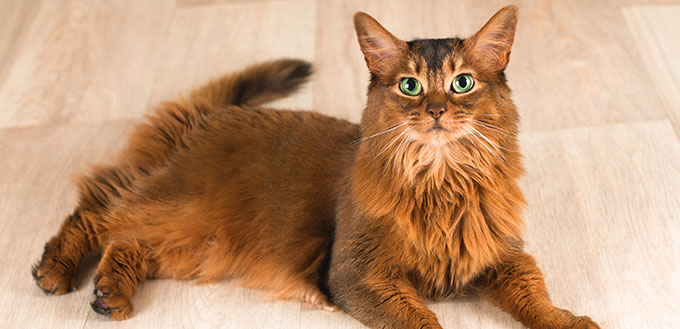Closely related to the Abyssinian cat, the Somali cat is a live-wire of epic proportions. Be prepared to deal with curtain-climbing, object-biffing and jumping fun from this boisterous and inquisitive cat. Want to know if the Somali cat is a good fit for your family? Then keep reading, to learn everything there is to know about Somalis.
History of the Somali Cat
The history of the Somali cat actually stems from its close relative, the Abyssinian. In the late Victorian era, showing your cat off was all the rage – and many fought to have the most beautiful cats, in order to win at cat shows. One of these shows resulted in the Abyssinian, in 1871, and it was here that this breed first came to light. Sadly, all we knew about this cat was that it was “captured in the late Abyssinian War”.
He took third place, which came as a surprise to many, as there were no records regarding the history or backstory of the cat breed. At the time, Harper’s Weekly was the first publication to have ever mentioned the cat breed at all, in January 27, 1872. Before this, there were no records of the cats’ origins.
In classic fashion, however, myths and speculation roared.
Which ranged from some claiming that the Abyssinian cat breed was the cat of the pharaohs. All the way through to the belief that the Abyssinian was created in Britain. With the latter case offering the explanation of silver and brown tabbies being cross-bred with cats that had “ticked” coats.
However, with today’s technology, cat DNA testing has shown that the Abyssinian actually came from the Indian Ocean coastal regions and parts of Southeast Asia. It is entirely possible that British and Dutch traders may have brought the cats over in their travels. In particular, those who came through ports in Calcutta, India, or the islands of Indonesia.
Giving further evidence to this theory, the Leiden Zoological Museum in The Netherland also plays host to a taxidermied specimen of a ruddy ticked cat exhibited in the 1830s. This cat was given the label of “Patrie, domestica India”. Suggesting that the cats with ticked coats came from a similar area.
Meanwhile, the name of the Abyssinian cat actually from Zula – the cat exhibited at the Crystal Palace. It was said that Zula was imported from Abyssinia (now Ethiopia).
Once the pedigree of the Abyssinian itself was established, by breeders such as Janet Robertson, it became clear that many had decided to crossbreed the cat with those who have longer hair. Since it is extremely rare for Abyssinian cats to hold the gene for their long-haired fur, so this could only have come from another breed, which did hold the gene.
It soon became a sought-after breed, to have the Abyssinian with a longer coat. And so, the Somali cat was created. In particular, by known breeders such as Evelyn Mague, who specialized in the Somali longhair gene pool. And who fought to have the Somali breed recognised. This long-haired relation of the Abyssinian was first discussed in the early 20th century. However, they did not have their own classification and set of breed markers until the 1960’s. Just as Somalia is next door to Abyssinia, the Somali breed was named for its close relation to the Abyssinian cat.
Breed Appearance
The Somali cats have an appearance that showcases their lively personality. This is a cat breed that exudes energy, with their almond eyes being bright green or gold from a young age (some kittens may have a blue look to these at first, but this will change over time).
Being long-haired, the Somali is a cat that requires some attention to their coat – with cat care centering around ensuring their tail remains free of dirt and debris from their trips outdoors. The most common colors for the Somali cat breeds are fawn or ruddy. Both the fawn coat and the ruddy coat of the cat have ticks of colors – usually a darker brown – within their hair.
Quick Facts About the Somali Cat
- The Somali is one of the rarest breeds, and they can therefore range between $1000 to $1500.
- Their coat is referred to as being “ticked” or “agouti”, this gives them a deep, stunning look.
- The average life span of the Somali is between 11 and 16 years of age
- Their beautiful long-haired coat is surprisingly easy to manage.
- Expect your Somali to be defter than other cat breeds – they can even hold things in their paws like a monkey!
- The most sought-after coat is the color ruddy. The ruddy Somali cat has hair that gives them the look of a fox.
- They are extremely curious and will climb up onto everything and anything, if it’s intriguing enough.
Things You Should Know
Health
Like any purebred cat, there may be some health issues prevalent in the breed. However, most of these can be ruled out by seeking out a registered, licensed breeder, who understands what to look for. A good breeder will only breed cats with a healthy background, while the everyday breeder is unlikely to check for genetic predispositions to diseases.
Progressive Retinal Atrophy
A degenerative eye disease that is common in many pure cat breed types. PRA affects the eyes as the photoreceptor cells deteriorate more quickly than usual. It is one of the most common diseases in purebreeds, regardless of the breed itself. This can affect their sight, eventually leading to blindness.
Reputable breeders should ensure that the Somali has a family line that is free of these traits. This will help your pet to live a long and happy life, and that their active nature can continue through their adult years and long into old age.
Hyperesthesia syndrome
The Somali is known for being quite a proud cat, with a tendency to groom their fur quite happily. In some, however, grooming can become near-obsessive. In these cases, the cats will often lose fur around their tail and legs, as they over-groom to the point of pulling the fur out.
It’s believed that this is due to an oversensitivity to touch, which may cause some Somalis to become jumpy when giving them a pet. It can also affect sensitivity to sound, smell and sight. If your cat is quite anxious, this may become worse. As such, it is worth taking a trip to the veterinarian if you’re concerned about your cat or kitten, or if their personality changes suddenly.
You may also like our article on Calming and Anti-Anxiety Products for Cats.
Renal Amyloidosis
Renal Amyloidosis is when the kidneys struggle to effectively filter the blood as it circulates due to amyloid deposits (a type of protein). As the kidneys ineffectively break down the proteins, the deposits build up, making it more difficult for your pet Somali to break down the proteins even further. Unfortunately, these health issues result in kidney failure. As such, it is important to see a veterinarian as soon as possible, if you suspect this.
Signs and symptoms of this include perceived weight gain, which is actually swelling. This typically occurs in the legs, but can also be seen in the face. You might also notice a change in their energy level, or behavior changes in their personality, as they will become lethargic and tired.
Pyruvate Kinase Deficiency
Another common health concern in Somali cats is PKD. Which is when the red blood cells are broken down too quickly by the body, before it can make new ones. This results in anemia which can drastically affect the personality of your kitten. It is a genetic condition, so breeders of Somalis should be able to reduce the likelihood of PKD being transferred to kittens by screening their cats before the breeders seek to breed their cats.
Feeding
Being so active, both the kitten and adult cat will need to have their weight managed appropriately. The best way for people to do this is to be mindful of how much food is being given to their cat, as is appropriate in pet care.
Take a look at our reviews of Cat Food for Indoor Cats and Organic Cat Food.
Care
Pet care is always important, and never more so than with kittens full of life, like the Somalis. In order to prevent periodontal disease, it’s important to brush the teeth of Somali cats – especially as the breed is more prone to dental issues than other household animals.
Read here our guides on the Best Cat Toothbrush and Best Cat Toothpaste.
You should also remember that the high activity level of Somali cats are part and parcel of their nature. While some people may not be suitable for cats that require a lot of attention, their active nature does make them ideal for busy households. Especially those with children and even dogs.
Grooming
Compared to some other long-haired cat breeds, the Somali is surprisingly easy to groom. Still, to provide the right amount of pet care for your Somali cat, it’s advisable that you give your cat a brush through, at least twice a week. Do this from a young age, and your cat will soon love the attention that they receive when this happens!
Check out our articles on the Best Brush For Cats and Best Cat Grooming Gloves.
Pay special attention to the ears. Having such fluffy ears, this cat breed is prone to picking up dirt and dust as they go about their travels. If this isn’t removed regularly, it could lead to an infection of the ears.
Take a look at our review of the Best Cat Ear Cleaners.
Temperament
The Somali is one of the most loving cat breeds, with all the traits of a family dog, and they will happily share their stage with children and dogs. The breed has even been known to prefer it, at times! With lots of people around, this pet will happily play all day, then turn into a lap cat at night.
These cat breeds are even prone to playing fetch with their humans and their love of attention will not wane as they grow into an adult pet. However, this also means that people should be wary of buying a cat due to it’s beautiful colors, as their traits mean that the Somali requires a lot of love and attention from their family.








